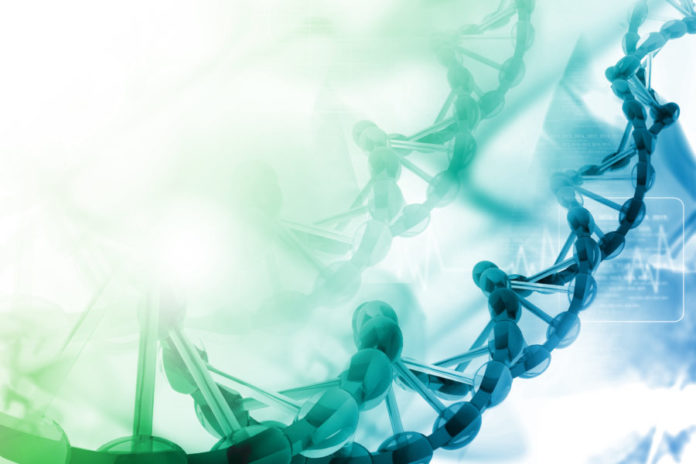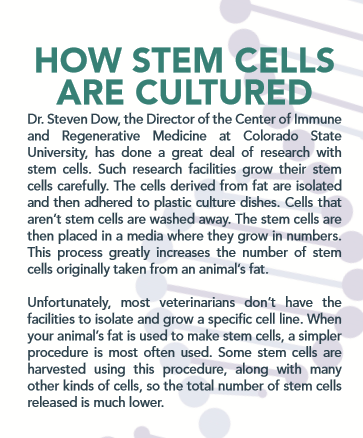Stem cells and your pet

We’re learning more all the time about stem cells and their mechanisms of activation, healing and regeneration, both in ourselves and our dogs and cats.
Stem cells are a really trendy subject nowadays, and there are many good reasons why. They’re the most important key to health, youth, regeneration and anti-aging in humans and animals. In this article, we’ll look at what stem cells are, and what triggers them to heal and repair tissues in our bodies, as well as those of our dogs and cats.
Defining stem cells
Stem cells are how we all started out. They’re the cells that develop into the different organs in our bodies when we and our pets are tiny growing embryos.
In mammals, stem cells regularly divide to repair and replace worn out or damaged tissues in the gut and bone marrow. In other organs, such as the pancreas and the heart, stem cells only divide under certain conditions. Without stem cells, wounds would not heal. Blood would not be able to regenerate. In fact, there would be no way to survive.
Stem cells, and the work they do, can vary from species to species. Salamanders can use their stem cells to regrow their tails, yet we humans certainly can’t regrow our fingers! Horses and cows have stem cells in their teeth, which replenish throughout their lives. As we and our animals age, however, the function of our stem cells declines.
In many tissues, stem cells serve as an internal repair system, dividing essentially without limit to replenish other cells, as long as the person or animal is alive.
Even after very long periods of inactivity, stem cells are capable of renewing themselves through cell division. Once they become active again, they can renew or replicate themselves for very long periods if they do not become specialized. Unspecialized stem cells can give rise to specialized cells, as they can be induced to change into specific tissues or organs.
Stem cell categories
It’s important to understand that there are different categories of stem cells, depending on their capabilities.
- Stem cells taken and saved from a newborn’s umbilical cord can develop into more than one cell type. These are called multipotent stem cells. They can make numerous kinds of tissues and some organs. What’s so important about umbilical stem cells is that the DNA is the same, so they’re not rejected.
- Stem cells taken from a pet’s fat are called monopotent stem cells. These are adult stem cells that can only differentiate into one kind of tissue. Monopotent adult stem cells can be harvested from tissues such as bone marrow or fat. Cells from fat can give rise to only a small number of cell types – i.e. connective tissue cells such as bone, cartilage and muscle. In pets, fat is often used as a source of stem cells for joint problems and for cartilage regeneration. Stem cells from our pets’ fat have been shown to have anti-inflammatory effects in joints and in other tissues. At Colorado State University, researchers have found these stem cells to be very helpful for feline kidney disease and some canine liver diseases, due to their anti-inflammatory effects.
Triggering stem cells – the role of kinases
The stem cells in our bodies, and those of our pets, work to regenerate and heal us, but the trick is knowing how to effectively trigger them. Scientists are now beginning to understand the signals that trigger stem cells to get going and start their repair work. These very important signals are carried by special messenger compounds called kinases.
Kinases comprise the repair and regeneration mechanism of the body. They have enormous diversity and play a critical role in cellular communication and signaling. A loss of function in kinases has been proven to cause cancer and other disease in humans. Kinases have the effect of making cells renew and reconstruct themselves. Importantly, they also stimulate and activate stem cells.
Kinases stimulate repair and activate stem cells. They are of ultimate importance to good health.
Drugs such as Apoquel and Cytopoint work to decrease allergic reactions by obliterating specific kinases. Apoquel detrimentally affects several different kinases. Cytopoint advertises that it destroys only one kinase, but as each kinase communicates with literally hundreds of others, obliterating even one has a cascade effect.
 Stem cell activators – buyer beware
Stem cell activators – buyer beware
We don’t preserve umbilical tissue from our dogs and cats, although this may evolve into an industry in the future. Our animals’ fat cells can be cultured to make stem cells, which are limited to forming connective tissue only. And as we and our pets age, the stem cells in our bodies become less vigorous.
Nevertheless, many products are being touted as stem cell activators. Whether all these products actually work is debatable. Cosmetic companies offer topical solutions to make your skin young again. Specific oral supplements claim the ability to activate stem cells. In fact, “stem cells” has become a buzz phrase to increase interest and sales. It’s being overused and generalized, and there are so many “stem cell-activating” products out there that researching every single one for efficacy would prove a daunting task.
However, for about four years, I have been successfully using stem cell-activating products made in France and approved for use in the United States. These products are not at all like the stem cells derived from a pet’s fat. They are not made from “self” but are created to target a disease in order to mend, improve or cure it. These products, in addition to cells from the placenta and umbilical cord, contain cells to direct healing to the targeted organ, along with superoxide dismutase, glutathione reductase, glutathione transferase, glutathione peroxidase, and kinase activators to increase communication within all body systems.
I have used these products (made by Biocell) for many different cases. For example, I have seen routine success using them in cats with FIP and lymphosarcoma. Amazingly, when these patients return to heath, they are actually cured. Remember, we are not using fat cells from the individual animal, which would be contraindicated in cancer — these are stem cell-activating products. Cure is achieved by activating the patient’s immune system and thymus gland. We are simply activating the patient’s own stem cells, which then work to cure what are considered incurable diseases.
The importance of the kinase communicators in our pets’ bodies cannot be underestimated. Thanks to them, an intricate and perfect system designed to maintain health at its best exists in every human and animal body. Working with that system constitutes holistic medicine in its purest form. In general, holistic modalities work to create a stronger, wiser and healthier body. Giving stem cells a nudge — getting them off the couch and back to work – produces a potent healing effect. For me, using stem cell-activating products for healing is extremely rewarding.



